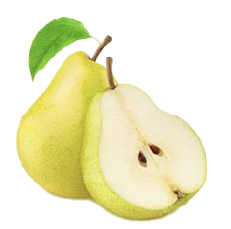Pear D'anjou
The variety of multiple uses.

Description
Also known in the USA as Anjou.
Occurs in the valleys of the Rio Negro and Neuquén province, where is the third variety in importance within this species. It blooms around the 20th of September. Your input in production is slow; it is autofértilalthough it is desirable for it to be pollinated by: Packhams Triumph, Cónference and other Beurré.
The fruit is piriformis short and globose with a broad base, of medium to large size, 270 to 285 grams, 85 mm high and 80 mm caliber.
The peduncle is short, thick and something meaty, cleft at the apex; the calyx is open, with the sepals united at the base.
The epidermis is fine and delicatelight green in color, although it does not change to yellow at maturity, with numerous lenticels well visible.
The pulp it is creamy white, of buttery texture, grainy, aromatic, juicy and sweet.
Source
The origin of the pear Danjou it is discussed, as some researchers consider it to be a native of Belgium and others in the region near Angers, in the centre-west of France, to the mid-NINETEENTH century.
Benefits
- Neutralizes the excess toxic waste own a diet rich in animal products.
- Helps maintain a healthy weight.
- Reduces the risk of diabetes.
- Provides anti-inflammatory properties.
Season Export
February – November
Pear D'anjou
The variety of multiple uses.
Description
Also known in the USA as Anjou.
Occurs in the valleys of the Rio Negro and Neuquén province, where is the third variety in importance within this species. It blooms around the 20th of September. Your input in production is slow; it is autofértilalthough it is desirable for it to be pollinated by: Packhams Triumph, Cónference and other Beurré.
The fruit is piriformis short and globose with a broad base, of medium to large size, 270 to 285 grams, 85 mm high and 80 mm caliber.
The peduncle is short, thick and something meaty, cleft at the apex; the calyx is open, with the sepals united at the base.
The epidermis is fine and delicatelight green in color, although it does not change to yellow at maturity, with numerous lenticels well visible.
The pulp it is creamy white, of buttery texture, grainy, aromatic, juicy and sweet.
Source
The origin of the pear Danjou it is discussed, as some researchers consider it to be a native of Belgium and others in the region near Angers, in the centre-west of France, to the mid-NINETEENTH century.
Benefits
- Neutralizes the excess toxic waste own a diet rich in animal products.
- Helps maintain a healthy weight.
- Reduces the risk of diabetes.
- Provides anti-inflammatory properties.
Season Export
February – November
